Zero3 G Low Expansion Low Fire Clear
|
Code # G2931G |
| Materials | Amt | |
|---|---|---|
| EPK | 27.296 | 27.03% |
| Silica | 13.265 | 13.13% |
| Ulexite | 26.085 | 25.83% |
| Ferro Frit 3249 | 18.622 | 18.44% |
| Wollastonite | 13.180 | 13.05% |
| Zinc Oxide | 2.551 | 2.53% |
Total:101.00
Auto Unity Formula
|
Si:Al: 5.4:1 6.2 (Molar:6.3) 13.2 Cost 0.31 per kg |
Notes
This is a low-expansion version of the Zero3 Clear glaze (code G2931K). While that glaze fits the vitreous Zero3 porcelain and stoneware and non-vitreous bodies containing talc (like Plainsman L212, L215), it crazes on others (e.g. Plainsman TerraStone, BuffStone, L210).
This version, G2931G, drops expansion drastically, from 7.4 down to 6.2 (it is a follow up to G2931B which was 6.5, this adds 0.1 ZnO at the expense of KNaO and CaO). It is thus possible adjust thermal expansion of either recipe by adding some of the other (to deal with shivering or crazing you encounter).
The soak:soak:slowdrop firing is critical for a defect free surface. This sacrifices some surface brilliance compared to G2931K. The chemistry cannot be produced using common North American frits, so Ulexite is employed (the original recipe from which the Zero3 glaze system was derived, Worthington Clear, was high in Gerstley Borate and made a jellied mess in the bucket, very difficult to use).
Do not try to use this with too little water. Mix it to 1.4 specific gravity and add vinegar or Epsom salts to gel it so that it stops moving (after vigorous stirring) in less than 2 seconds. It naturally gels so little vinegar should be needed. It applies very well to low or high porosity bisque (in a very thin layer if needed), it does not drip or move but does take a minute to dry.
The soak:soak:slowdrop firing schedule is critical to a defect-free surface.
Pictures
Terra cotta and thermal shock
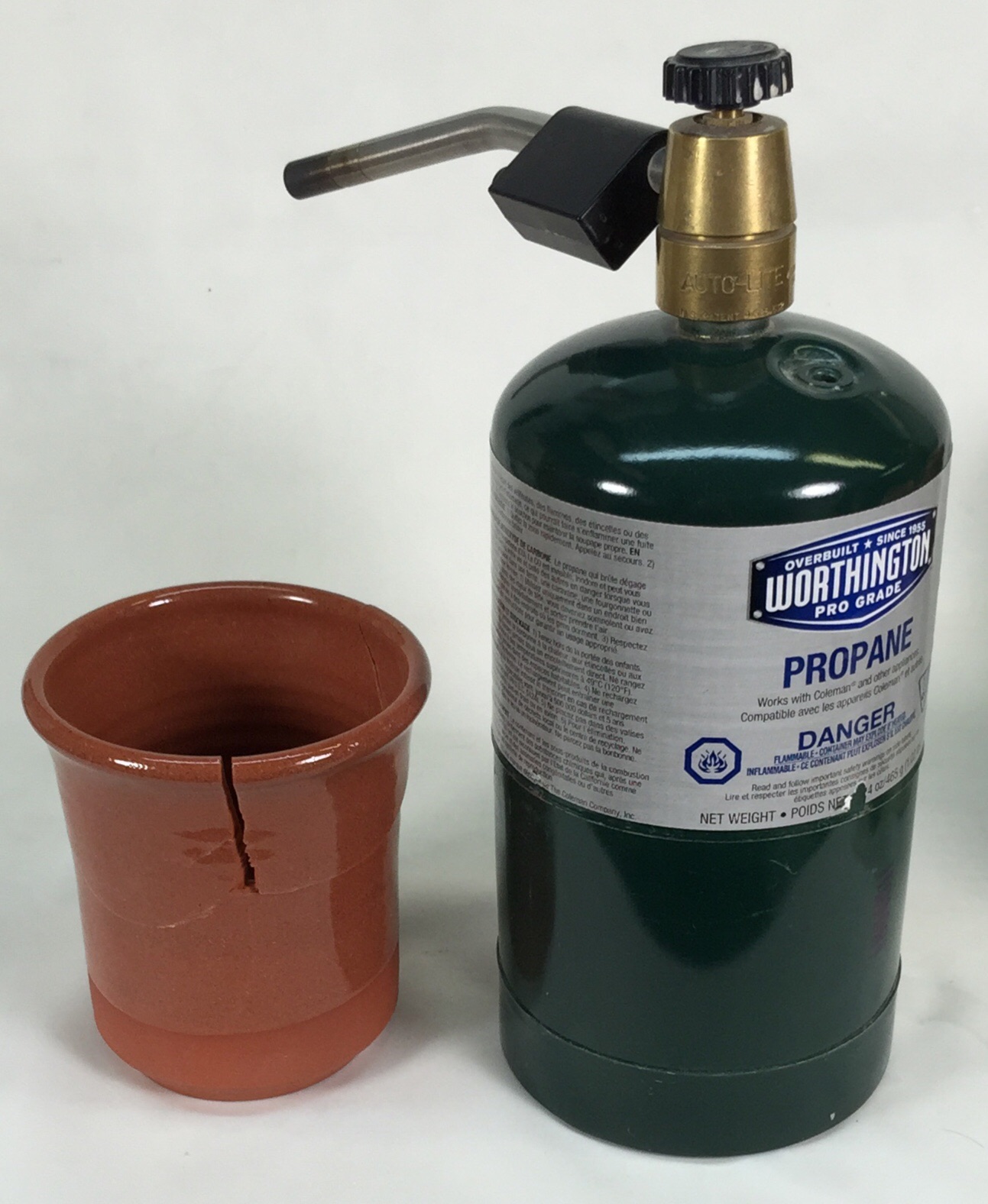
This terra cotta cup is glazed with G2931G clear glaze and fired at cone 03. It survives 25 seconds under direct flame against the sidewall before a crack occurs. Typical porcelains and stonewares would survive 5-10 seconds!
This is a key advantage of earthenware. Sudden changes in temperature cause localized thermal expansion, this produces tension that easily cracks most ceramics. But the porous nature of earthenware absorbs it much better.
P6318 Terrastone with G2931G Clear Glaze cone 03

G2931G clear shivering on 3724N1 (fritted terra cotta) at cone 03

G2931F (left), G2931G (right) on buffstone
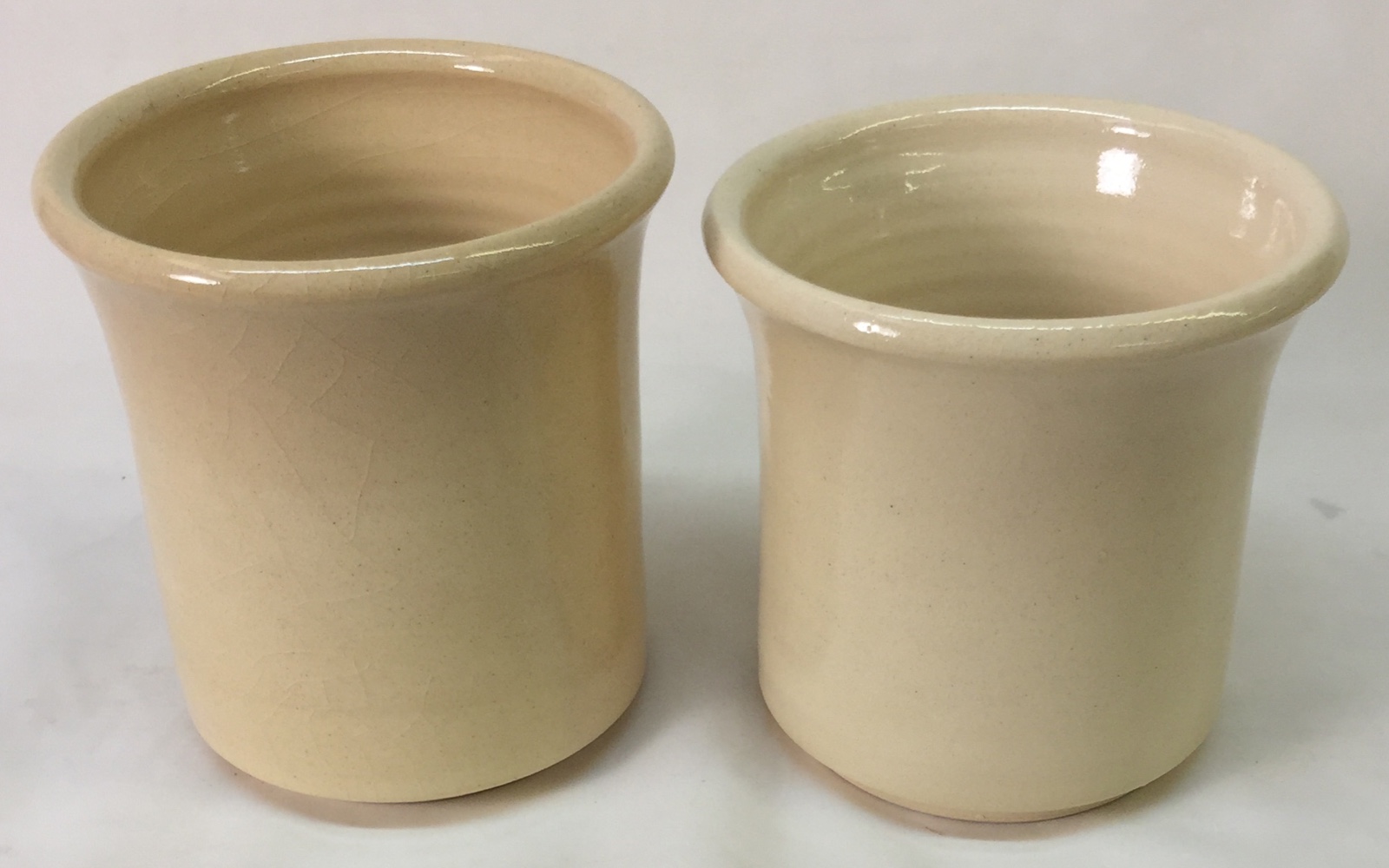
Cone 03. Did boiling water, ice water test on both. F crazes (notice the piece is waterlogged). G does not. Buffstone has a high porosity at this temperature so glazes must fit well.
P580 Pioneer cone 10R bisqued with 2931F and G glazes
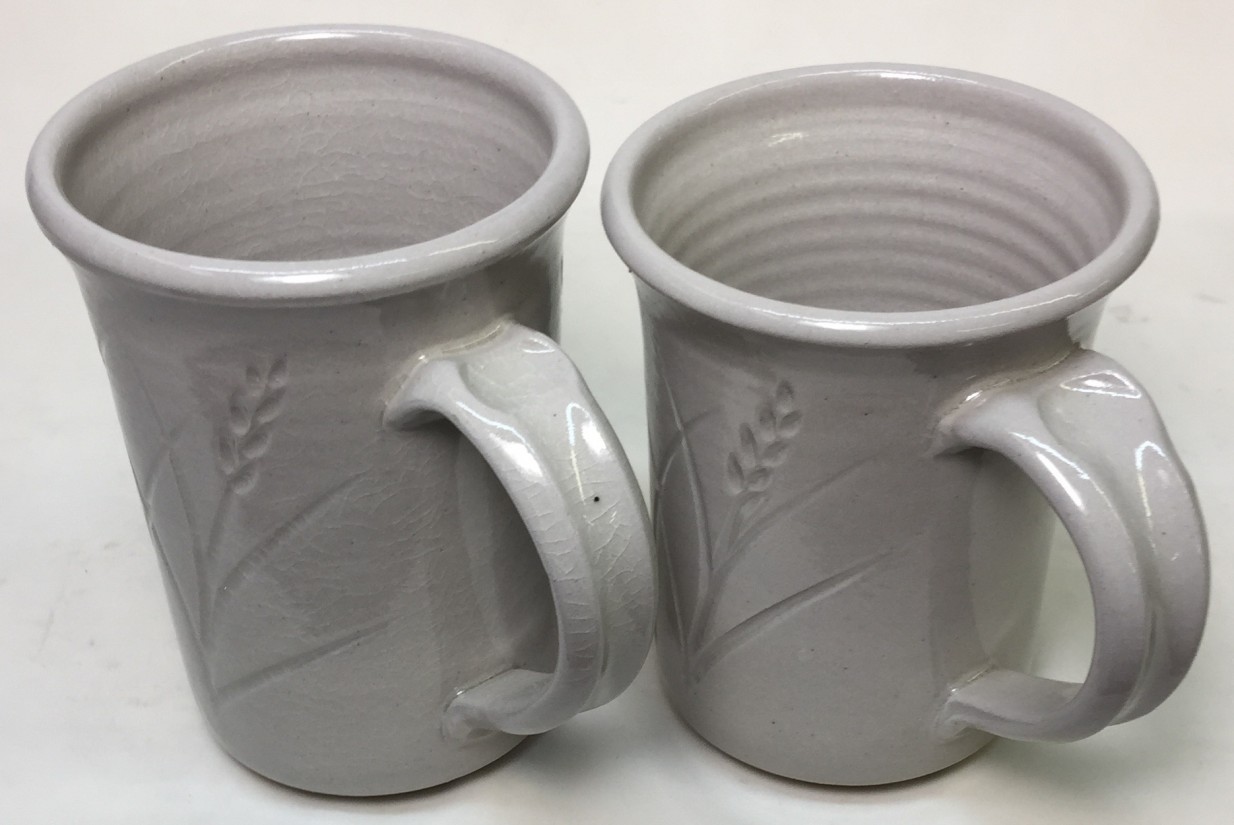
F crazes. G does not. Both need to be applied thicker.
P580 with cone 03 clear vs cone 10 clear

G2931G clear on cone 10R bisqued piece (left).
G1947U cone 10R glaze (right).
The G need a tiny amount of blue stain.
Cone 04 Melt flow comparison G3879C vs G2931G
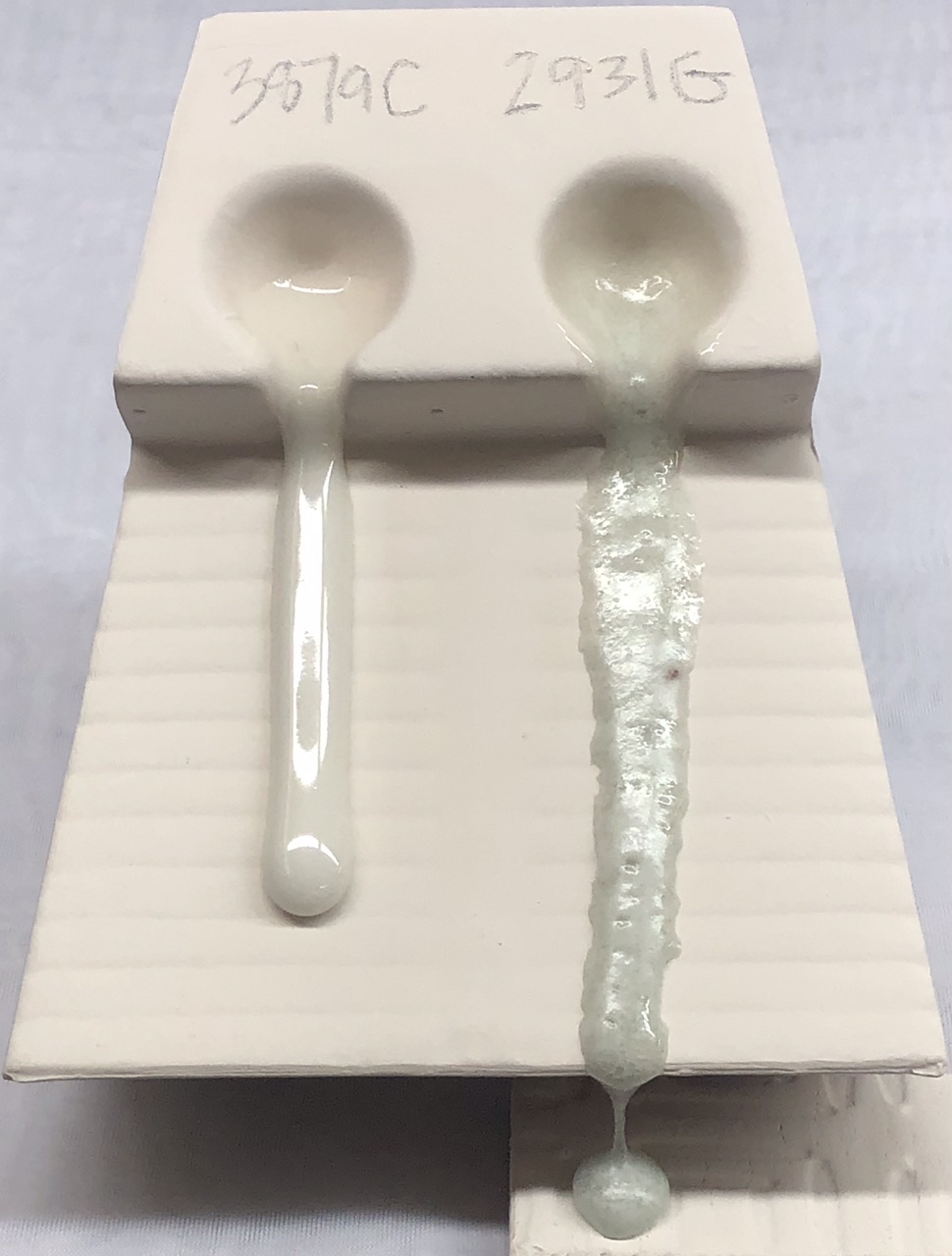
XML (to paste into Insight)
<?xml version="1.0"?> <recipes version="1.0" encoding="UTF-8"> <recipe name="Zero3 G Low Expansion Low Fire Clear" id="76114" key="NS5c6kYB" date="2021-09-11" codenum="G2931G" picturebasename=""> <recipelines> <recipeline material="EPK" amount="27.296" tolerance=""/> <recipeline material="Silica" amount="13.265" tolerance=""/> <recipeline material="Ulexite" amount="26.085" tolerance=""/> <recipeline material="Ferro Frit 3249" amount="18.622" tolerance=""/> <recipeline material="Wollastonite" amount="13.180" tolerance=""/> <recipeline material="Zinc Oxide" amount="2.551" tolerance=""/> </recipelines> </recipe> </recipes>
Born: 2014-03-19, Modified: 2021-09-11 20:11:26
Zero3 K Cone 03 Transparent Glaze
|
Code # G2931K |
| Materials | Amt | |
|---|---|---|
| Ferro Frit 3195 | 25.000 | 26.32% |
| Ferro Frit 3134 | 33.000 | 34.74% |
| EPK | 20.000 | 21.05% |
| Ferro Frit 3249 | 10.000 | 10.53% |
| Ferro Frit 3110 | 7.000 | 7.37% |
Total:95.00
Auto Unity Formula
|
Si:Al: 6.1:1 7.4 (Molar:7.5) 3.1 Cost 0.24 per kg |
Notes
This recipe improved on the popular Worthington Gerstley-Borate-based low fire clear recipe. It targeted cone 03 to work best on Zero3 stoneware and porcelain. To fire lower (cone 06-04), consider G1916Q (or derivatives) instead.
Unlike its Worthington Clear predecessor, this does not become a bucket of jelly, does not crack on drying, does not go on unevenly or the wrong thickness, does not cloud up with boron blue or micro-bubbles when fired (because it has lower CaO) when used on the types of bodies discussed below. It is crystal clear and super glassy at cone 03.
If you liked the variegated appearance of the GB version, titanium dioxide can be added to this to produce even better variegation. For darker color rutile with do the same.
Low fire bodies span a wide range of thermal expansions. While Worthington clear (an ancestor of this recipe) melts to a good clear, its thermal expansion was too low. This recipe, G2931K, raises thermal expansion (by adding Na2O). The thermal expansion of Zero3 stoneware and porcelain are about the middle of the range, and they develop good glaze:glaze interfaces, so this recipe fits them well.
This glaze shivers on high-talc bodies and can craze on zero-talc porous ones. This recipe has three variations we have worked with, one of higher expansion (G2931H) and one of lower expansion (G2931L). Keep in mind that adding zircon and stains changes expansion.
Dipping ware in Zero3 Transparent is just so much easier than trying to paint on commercial, slow-drying clears. For us it naturally gels to a creamy consistency at around 1.53 specific gravity (in our circumstances). However it goes on too thick at that high a value, we have found the best all-around performance at 1.43 with enough Epsom Salts to gel it back up to a creamy thixotropic consistency (a few grams per gallon).
Pay special attention to the drop-and-hold firing schedule, especially if your clay body is not fine-grained. Use 04DSDH as a model.
To mix up 5 Kg use about 4.5 kg of water to get 6.5 litres of dipping glaze. To make a brushing glaze: For each 100g of powder mix start with 125 water, 1.5 CMC gum and 1.5 Veegum and thoroughly mix in a kitchen blender (add water if it gels too much). We find the about 330g of powder produces a 500ml (about 1 pint) jar.
To make colored versions add stains as needed (if stains cause micro-bubbling or orange peel surface include 2-3% zircopax).
Batch Ticket Notes
These notes were entered in the notes panel under "Batch Ticket Notes"
Pictures
G2931K on Zero3 Stoneware

Fired cone 03. Body is Zero3 stoneware.
Surface is perfect, even where thick. Ultra clear.
Survived three boil:ice cycles and one 300F:ice cycle without crazing.
G2931F vs. G2931K on Polar Ice Low Fire

2931F was the Ulexite flused version of this recipe. The F survived three boil:ice cycles and 1 300F:ice cycle without crazing or shivering.
The K is slightly smoother, tiny dimples in the surface are fewer. It is also applied thicker.
G2931F vs G2931K fritted - terra cotta mugs cone 03

F was the Ulexite-fluxed version of this recipe.
G2931F vs G2931K flow test
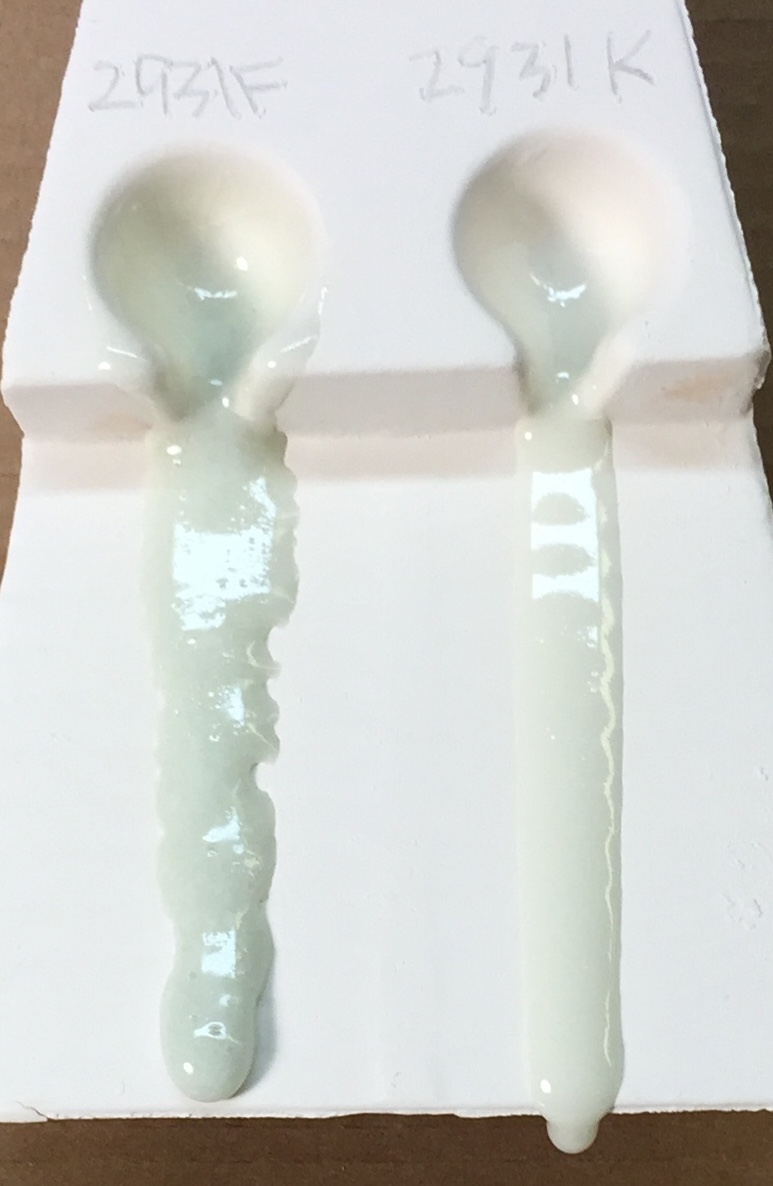
These two recipes have the same chemistry, but K sources boron from frits rather than Ulexite. Notice how much less bubbles there are in the flow and how much more predictable the melting pattern is.
G2931F vs G2931K - Melted balls at cone 03

F, the Ulexite version, is obviously bubbling more, the percolation is causing the melt to spread out more on the tile. On the flow test is was less fluid.
Firing temperature is important for Zero3 glaze

This is G2931F on Plainsman Buffstone, L213, F100, L215. First column is cone 04, center is cone 03, right is cone 02. All exited the kiln without crazing except Buffstone at cone 04.
We subjected all of them to a 300F:IceWater thermal shock.
Buffstone crazed on all of them.
L215 and L212 Cone 04 crazed.
L213 was good but later the glaze was found to be under excessive compression, subject to shivering over underglazes.
At cone 02 there are some dimples and defects.
Three low fire bodies that need three clear glazes
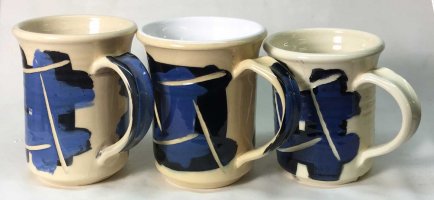
Because of glaze fit. Left: Plainsman Buffstone, contains no talc, fires buff. Center: L212 (about 25% talc). Right: L213 (about 45% talc, fires whiter). Talc raises thermal expansion. The centre glaze is G2931K (Insight-live reports COE 7.4), it fits L215 (also Zero3 porcelain and stoneware). It crazes on Buffstone and shivers on L213 and L212. G2931L has lower expansion (to work on zero-talc porous bodies). G2931H is higher (for talc bodies like L213).
G2931K glaze precipitates things on storage

G2931K On L212 after a year

Some crazing starting.
K on L215 at cone 04

The thicker version is clouding. The thinner one has micro-pinholes. It needs a higher temperature.
G2931K o L215 - Cone 03, thick application

G2931K on L215 - Cone 03 fired in 30 minutes
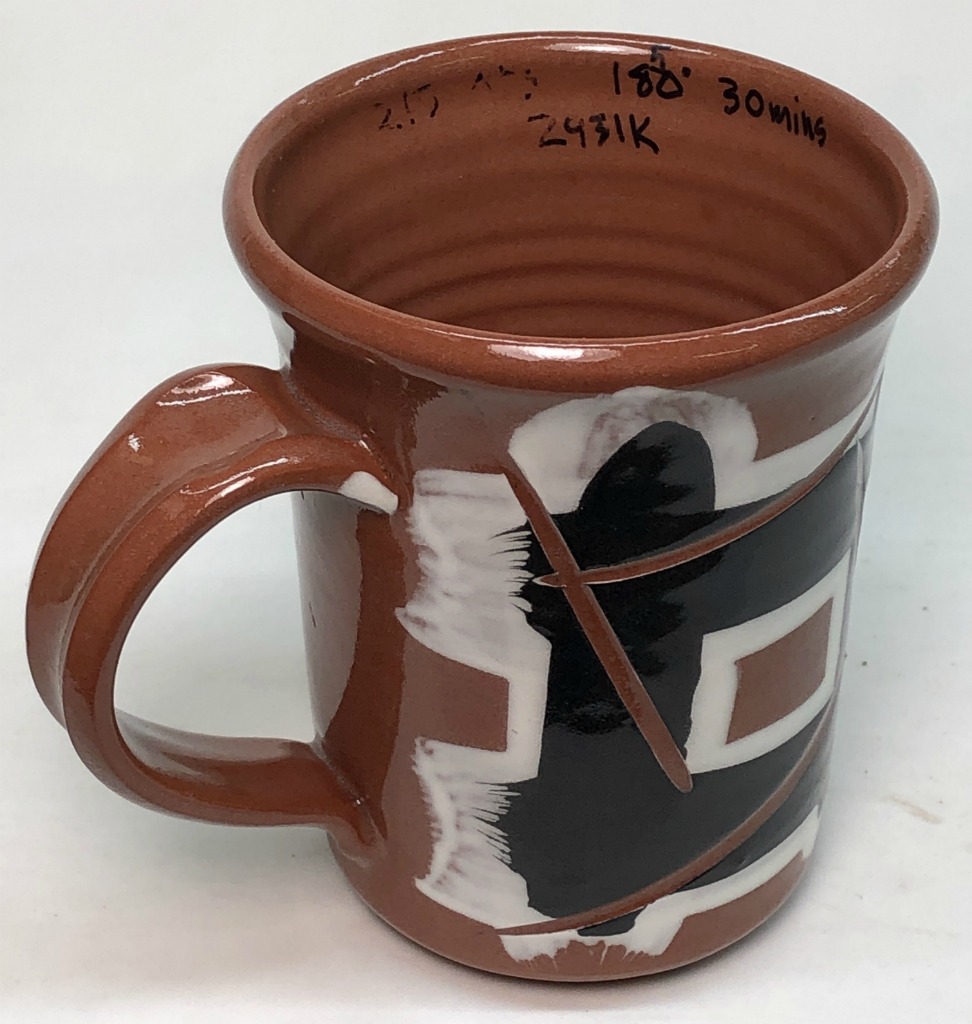
Very transparent. No crazingafter many months.
G2931K on L215 - Cone 06

Milky (because cone 06 is underfired for this glaze). But only a little crazing after a year.
G2931K running on Zero3 Casting

This happened at cone 03 and 04. The G3879 (left) did not run. For some reason G2931K easy applies to thickly on this body.
This 1000 gram batch of glaze powde
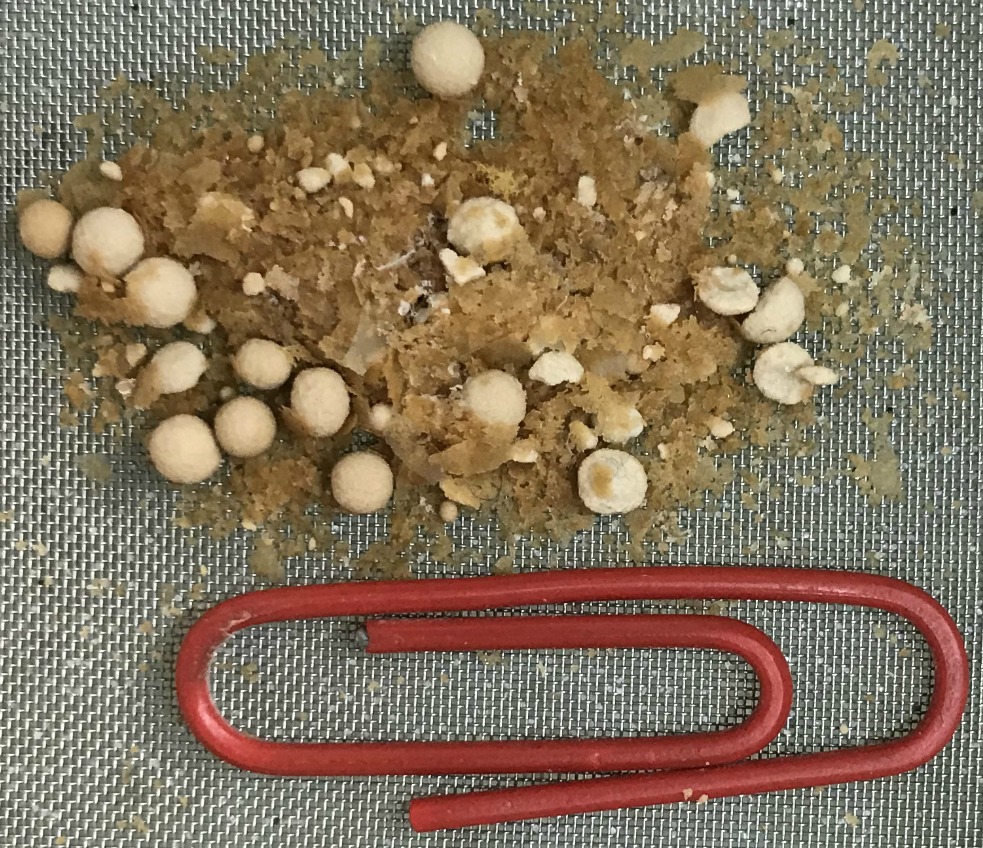
This 1000 gram batch of glaze powder screened 80 mesh immediately after making, and allowed to sit for 3 months prior to usage.
The material in photo was screened out once again after the 3 month time lapse, (80 mesh once again).
The largest balls are approx. 2.5 mm. in diameter, and when these particles were screened out, and still perhaps slightly wet?, they were quite easy to break in half with your fingernail.
G1916Q (left) vs G2931K (right) at cone 04

On a terra cotta body, the G1916Q is performing better, there are less micro bubbles.
URLs
How to tune the thixotropy of a glaze
How to convert a d..o a brushing glaze
Typecodes
ST-Untitled typecode
Alternate Code Number:GS04-1
XML (to paste into Insight)
<?xml version="1.0"?> <recipes version="1.0" encoding="UTF-8"> <recipe name="Zero3 K Cone 03 Transparent Glaze" id="95671" key="H7gMxybs" date="2023-05-03" typecodes="ST" codenum="G2931K" picturebasename=""> <recipelines> <recipeline material="Ferro Frit 3195" amount="25.000" tolerance=""/> <recipeline material="Ferro Frit 3134" amount="33.000" tolerance=""/> <recipeline material="EPK" amount="20.000" tolerance=""/> <recipeline material="Ferro Frit 3249" amount="10.000" tolerance=""/> <recipeline material="Ferro Frit 3110" amount="7.000" tolerance=""/> </recipelines> </recipe> </recipes>
Born: 2006-03-16, Modified: 2023-05-03 20:54:14
Worthington Cone 06-2 Clear
Gelling, High LOI, Gerstley Borate difficult to sub, High Boron
|
Code # G2931 |
| Materials | Amt |
|---|---|
| Gerstley Borate | 55.000 |
| EPK | 30.000 |
| Silica | 15.000 |
Total:100.00
Auto Unity Formula
|
Si:Al: 5.3:1 6.5 (Molar:6.6) 20.7 Cost 0.34 per kg |
Notes
This recipe is a common Gerstley Borate clear base used from 04 all the way to cone 6! At higher temperatures the recipe trends toward less kaolin to more silica and a little less GB (e.g. 50:20:30).
Attractions its simple make-up and crystal clear fired result (low bubble population). Although it can also fire with clouding, variegation and boron blue depending on thickness, the clay body and firing.
The high boron content of Gerstley Borate, enabling high melt fluidity, make this glaze possible. Potters use it on terra cotta, talc and stoneware bodies that generate lots of gases of decomposition and this can often pass and heal bubbles well. High boron clear glazes like this are known for clouding issues (because of micro bubbles) but this has a low enough surface tension to pass them.
Problems with this recipe:
Obviously, if it melts well already at cone 04 great care is going to be needed at cone 2 to prevent it running onto shelves. Highly melt fluid glazes (that have high boron like this) are also more likely to be leachable and to crystallize on cooling (producing the boron-blue clouds).
Paramount is the dreadful problem of gelling. Even with only 1.4 specific gravity (about equal weights of dry material and water and deflocculation with Darvan) it gels badly. The high water content needed and the nature of GB means that glazed ware dries extremely slowly, the glaze shrinks and cracks during drying and crawls during firing. Gerstley Borate is very plastic, yet to make matters worse, the recipe has an additional 30% clay on top of that! This recipe can actually be thrown on a potters wheel!
The thermal expansion is too low for talc bodies, it will shiver on them.
Pictures
Worthinton Clear at cone 01
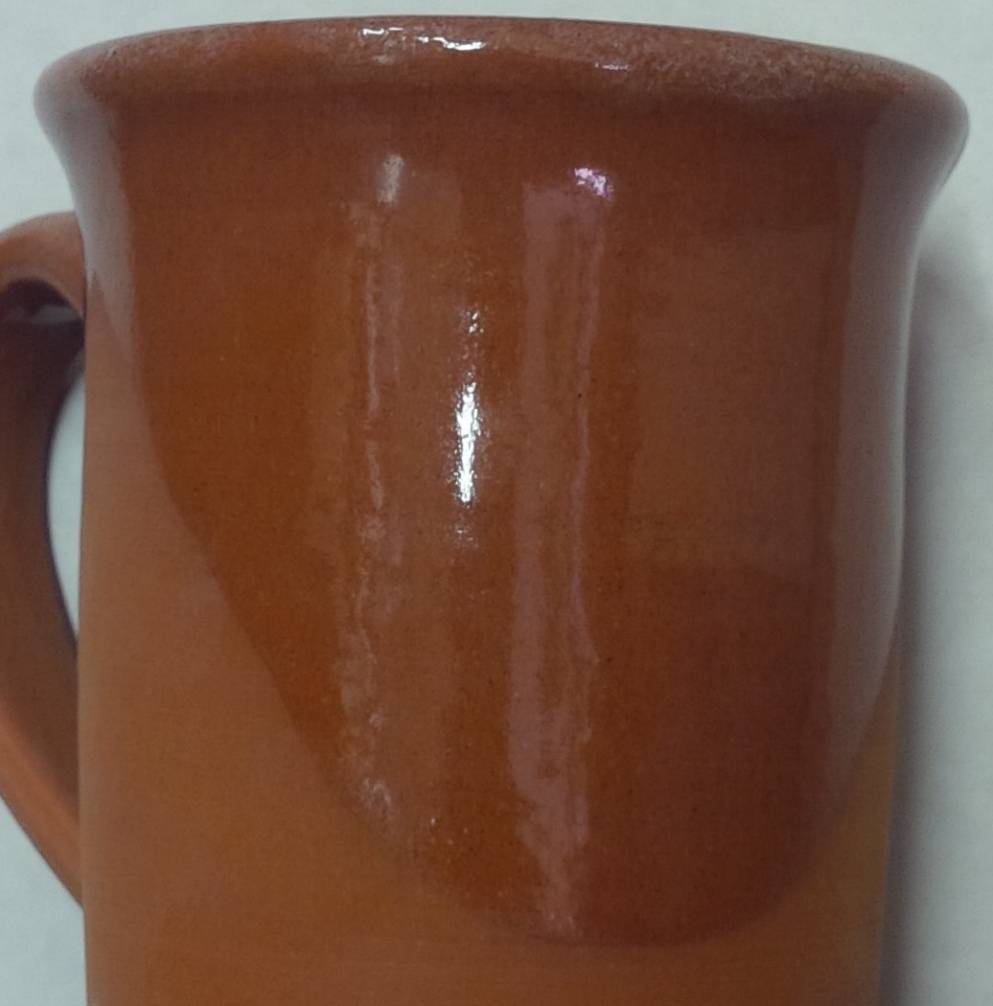
On a terra cotta clay at this temperature was has stoneware properties. The fired surface is good.
Worthington Clear vs. Fritted Clear

Worthington (right) flows even better than the fritted glaze and does not have any more entrained bubbles even though it has an LOI of 20%. This is likely because its melting history and behavior is such that its ability handle gases of decomposition from the body and its own materials is so much better.
2931 vs 2931b
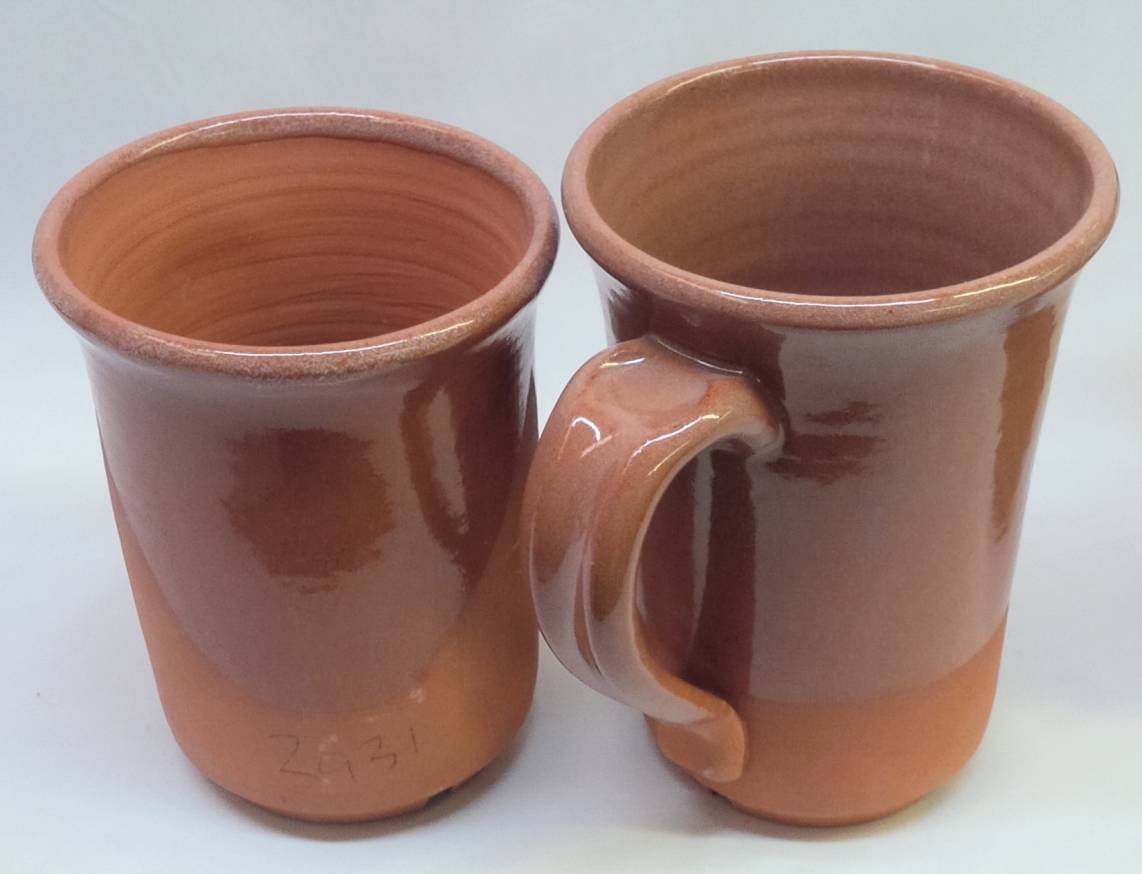
On Plainsman L215 cone 02 the original base Worthington Clear has gone on very thin on sides of mug (because of the low specific gravity necessary to prevent it from gelling it is very difficult to get it on thick enough). The fired surface is clear but not as glossy. On the rim it has bubbles. The Ulexite version (G2931B) is glossier, and went on thicker because the slurry is so much easier to use. This glaze is not recommend for L215, the latter contains talc that increases its thermal expansion, putting too much squeeze on this glaze.
Entrained bubbles in Worthington Clear
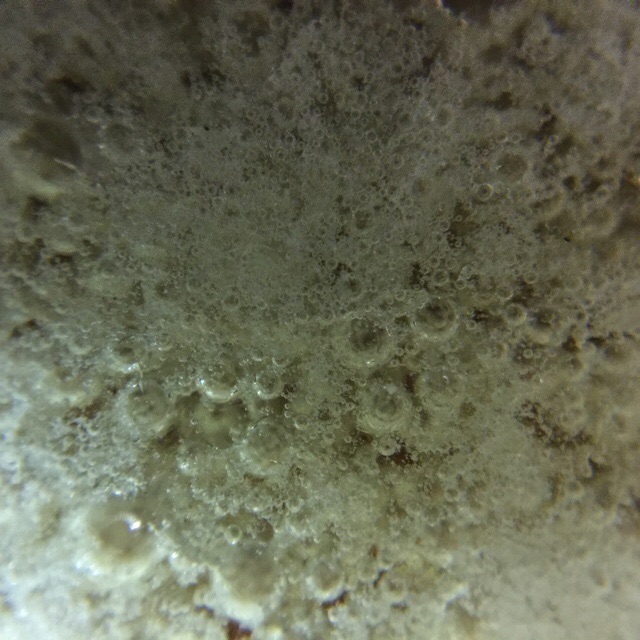
This is a 16X closeup of flow test (10 gram ball melted down onto a tile) that concentrates bubbles. There are high populations of large and tiny ones. The larger ones are from the Gerstley Borate, the tiny ones from the kaolin.
GB vs Ulexite Clear glaze bubbles

These are 10 gram balls fired down onto tiles at cone 04 to compare melt fluidity and bubble populations in three clear glazes. Larger bubbles are better, they break at the glaze surface and heal. Tiny ones produce cloudiness.
Left: The original Worthington fluid melt clear glaze recipe. There are clusters of tiny bubbles and many large.
Center: A glaze of the same chemistry but sourcing its boron from Ulexite instead. Notice the lack of tiny bubbles. This fires pretty well identical to the original but has much better slurry properties.
Right: Center with with a 10% addition of lead bisilicate frit. This fires more glossy than either of the other two. Its thermal expansion is also likely lower.
Worthington Clear the next day

Even though this has a low specific gravity and is deflocculated with darvan, the next day it is still jelly. Impossible to use unless more Darvan is added, who knows where that will go!
G2922G, G2931 flow tests

Testdata
SHAB - Shrinkage/Absorption
| DLEN | DSHR | FSHR | ABS | |
| 1 | 92.24 | 7.8% | ||
| 2 | 92.11 | 7.9% |
LDW - LOI/Density/Water Content
| WWGT | DWGT | H2O | LOI | DENS | |
| 1 | 13.52 | 10.26 | 24.1% |
XML (to paste into Insight)
<?xml version="1.0"?> <recipes version="1.0" encoding="UTF-8"> <recipe name="Worthington Cone 06-2 Clear" keywords="Gelling, High LOI, Gerstley Borate difficult to sub, High Boron" id="56711" key="Q7Ke15KM" date="2025-04-06" codenum="G2931" picturebasename=""> <recipelines> <recipeline material="Gerstley Borate" amount="55.000" tolerance=""/> <recipeline material="EPK" amount="30.000" tolerance=""/> <recipeline material="Silica" amount="15.000" tolerance=""/> </recipelines> </recipe> </recipes>
Born: 2014-03-17, Modified: 2025-04-06 20:26:29
Firing Schedule Name
Cone 03 hold-rise-drop-hold
Degrees (Fahrenheit or Celcius)
F
Schedule Type
Rate
Start Time and Temperature
8:01 am at 80F
Program
| Step | Degrees/Hr | Temperature Monitor |
Hold Time |
Accumulated hrs:min |
Time | Note |
|---|---|---|---|---|---|---|
| 1 | 400 | 240 | 60 | 1:24 | 9:25 am | |
| 2 | 350 | 1850 | 30 | 6:00 | 2:01 pm | |
| 3 | 108 | 1950 | 10 | 6:55 | 2:56 pm | |
| 4 | 500 | 1850 | 30 | 7:07 | 3:08 pm |
Notes
Used to glaze fire Zero3 porcelain and stoneware. However, there is a caution about bisquing these frit-containing bodies: They will vitrify in a typical firing, you must reduce the temperature to around 1500F (if ware is not absorbent enough fire lower). Note: this schedule is for the glaze firing, the previous two sentences simply referenced what is needed for the bisque.
This can start and finish more than once in a working day. Step 2 can often be done as fast as your kiln will go (cold-to-cold in three hours is possible).
The soak at 240F does not fracture ware even though it is above the boiling point of water. We find this is needed to be sure ware is sufficiently dry to withstand the rapid ascent to 1850. If your ware is thicker a slower ascent may be needed.
The 1850 soak on the way up clears the clouds of microbubbles. The 1850 soak on the way down heals the defects (blisters, pinholes) because the increasing viscosity is enough to overcome the surface tension holding bubbles from breaking).
It may be necessary to alter the last step if any imperfections are present. Try dropping to 1800 or 1750 and holding there. An additional step could be added to cool at 100F/hr down to 1500.
